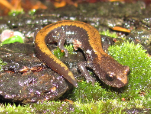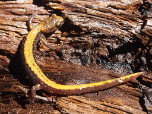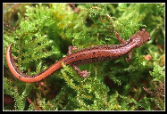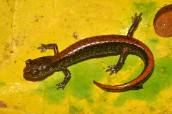Larch Mountain Salamander (Plethodon larselli)
Description: The Larch Mountain salamander is a small, terrestrial salamander. The species is characterized by a variable dorsal stripe, typically orange, light brown, or yellow, which is often blotchy. The ground color is brown, with light speckling in certain areas. This species is easily distinguishable from other western Plethodon by its reddish-salmonish venter. Adults are typically just smaller than 2 inches in snout-to-vent length, with a mode of 15 costal grooves.
Habitat: This species inhabits lava talus slopes in Douglas Fir stands, and is typically found under canopy cover in talus of suitable size that has accumulated considerable amounts of humus. It rests under rocks and bark and in rotten wood, and moves deep under talus in cold weather or when it is dry or hot. This species is associated with steep, at least partially forested talus slops, although it has also been found in forests with no exposed talus. Breeding occurs in the same habitats in late autumn or spring on warm rainy nights, and is by direct development. This species does not tolerate the loss of canopy cover, which appears to allow congeners to outcompete it.
Range: This species is only found in a narrow region of southwest Washington and northwest Oregon, where the Cascades Range has been eroded by the Columbia River in the Columbia River Gorge. Four subpopulations are known from near Mount Saint Helens, and just south of Mount Rainier. It occurs at elevations up to 1,036 meters asl.
Found in these States:
OR |
WA
Diet: Larch Mountain salamanders are predators on a variety of invertebrates.
Reproduction: Breeding season is spring and fall. Eggs are most likely laid in underground dens, although none have been found to date. Do not have an aquatic larval stage, hatch directly into small salamanders.
Status: Listed as Least Concern in view of its relatively wide distribution, presumed large population, and because it is unlikely to be declining fast enough to qualify for a threatened listing.
»» Kingdom: Animalia - Animals
»» Phylum: Chordata - Chordates
»» Subphylum: Vertebrata - Vertebrates
»» Class: Amphibia - (Amphibians)
»» Order: Caudata - Salamanders
»» Family: Plethodontidae - Lungless Salamanders
»» Genus: Plethodon
»» Species: Plethodon larselli - Larch Mountain Salamander
This article uses material from the Wikipedia article "Larch Mountain Salamander", which is released under the Creative Commons Attribution-Share-Alike License 3.0. Content may have been omitted from the original, but no content has been changed or extended.
|













